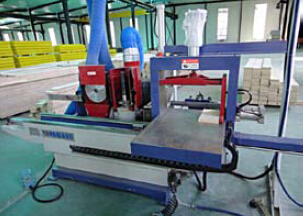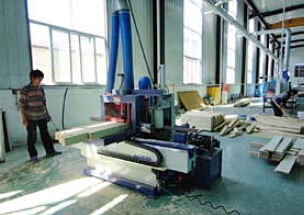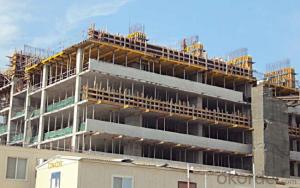Timber-Beam Formwork H20 for formwork and scaffolding systems
- Loading Port:
- Tianjin
- Payment Terms:
- TT OR LC
- Min Order Qty:
- 50 m²
- Supply Capability:
- 1000 m²/month
OKorder Service Pledge
Quality Product, Order Online Tracking, Timely Delivery
OKorder Financial Service
Credit Rating, Credit Services, Credit Purchasing
You Might Also Like
Characteristics:
◆ Standardized production lines.
Supply capability: 3000m/day, Lmax = 6600mm.
◆ Finger jointing of the flange and web, the strength of timber beam is highly improved.
Max. shearing force failure load:40KN
◆ Well treated to prevent from water penetration or erosion, so the service life maximally
extended.
Normally, CNBM timber beam H20 can be used for 4 to 5 years, the exact using time would
depend on maintenance & storage.
◆ Robust caps at the end of the girders protect against damages.




- Q:Can steel formwork be used for both vertical and horizontal concrete structures?
- Indeed, both vertical and horizontal concrete structures can benefit from the utilization of steel formwork. The versatility of steel formwork grants the ability to effortlessly modify and construct diverse shapes and sizes for varying structures. This resource supplies robust reinforcement, stability, and longevity, thus rendering it appropriate for vertical walls and horizontal slabs alike. Moreover, steel formwork boasts exceptional accuracy in dimensions, guaranteeing meticulous concrete placement and alignment. Furthermore, steel formwork's reusability renders it an economically efficient choice for construction endeavors mandating recurrent employment of formwork systems.
- Q:How does steel formwork handle different concrete air content requirements?
- Steel formwork is a durable and versatile construction material that can effectively handle different concrete air content requirements. Concrete air content refers to the amount of air trapped within the concrete mixture, which is crucial for various reasons such as improving workability, durability, and resistance to freezing and thawing cycles. Steel formwork is designed to provide a strong and rigid structure to contain and shape the concrete during the pouring and curing process. Since the formwork is made of steel, it is not permeable, meaning it does not allow air to pass through. This prevents any air from escaping the concrete mixture, ensuring that the desired air content is maintained. To handle different concrete air content requirements, steel formwork can be customized or adjusted accordingly. For instance, if a higher air content is required, the formwork can be designed with additional space or voids to accommodate the desired amount of air within the concrete. On the other hand, if a lower air content is needed, the formwork can be designed to minimize any potential air entrapment by ensuring tight connections and smooth surfaces. Additionally, steel formwork can also be used in conjunction with other techniques to control the air content in concrete. For example, the formwork can be combined with the use of air-entraining admixtures, which are additives that are mixed with the concrete to purposely introduce air bubbles. These admixtures create a more uniform distribution of air throughout the concrete, and the steel formwork helps to retain this air during the pouring and curing process. In summary, steel formwork is well-suited for handling different concrete air content requirements due to its impermeability and customizable nature. It provides a reliable and robust structure to contain the concrete while ensuring that the desired air content is maintained, either by creating additional space for higher air content or by minimizing air entrapment for lower air content. Additionally, it can be used in conjunction with other techniques such as air-entraining admixtures to further control the air content in concrete.
- Q:Can steel formwork be used in coastal or marine construction projects?
- Yes, steel formwork can be used in coastal or marine construction projects. Steel formwork is known for its durability and strength, making it a suitable choice for projects in harsh environments such as coastal or marine areas. Its resistance to corrosion allows it to withstand the corrosive effects of saltwater and other coastal elements. Additionally, steel formwork can be easily reused and recycled, making it a cost-effective and sustainable option for coastal or marine construction projects.
- Q:Can steel formwork be used in areas with limited construction space or tight site constraints?
- Yes, steel formwork can be used in areas with limited construction space or tight site constraints. Steel formwork systems are highly versatile and can be customized to fit into small or irregularly shaped spaces. They can be easily adjusted and modified to accommodate different project requirements and site constraints. Additionally, steel formwork offers high strength and durability, allowing for efficient construction even in challenging site conditions.
- Q:What are the common design considerations for steel formwork in seismic areas?
- To ensure the safety and stability of structures in seismic areas, there are several important factors to consider when designing steel formwork. These factors include: 1. Material strength: It is crucial to use steel with high tensile strength and ductility to withstand seismic forces. Utilizing high-strength steel, like Grade 60 or Grade 80, is often necessary to ensure the formwork can endure the lateral forces generated during earthquakes. 2. Connection details: The connections between different components of the steel formwork must be meticulously designed to withstand seismic loads. Employing proper welding or bolting techniques is essential to ensure the connections are strong enough to resist dynamic forces. 3. Reinforcement: To enhance the structural integrity of the formwork, additional reinforcement such as steel bars or mesh may be required. This reinforcement helps distribute seismic forces and prevents the formation of weak points or failure zones. 4. Stiffness and rigidity: The formwork system should be designed to be adequately stiff and rigid, minimizing deformations and preventing excessive movement during earthquakes. This can be achieved by using thicker steel plates or incorporating diagonal bracing elements to increase overall stiffness. 5. Anchorage and support: To prevent shifting or collapsing during seismic events, the formwork needs to be securely anchored to the ground or supporting structure. Incorporating adequate anchorage and support systems, such as anchor bolts or braces, into the design is crucial for formwork stability. 6. Compatibility with other building components: Consideration must be given to the compatibility of the steel formwork with other structural elements, such as concrete walls or columns. Proper coordination and integration with other building components are essential for overall stability and seismic performance. 7. Robustness and redundancy: The formwork design should incorporate features that provide redundancy and robustness, enabling it to withstand unexpected loading conditions or localized damage during earthquakes. This can be achieved by incorporating multiple load paths or redundant structural elements into the formwork system. In summary, the design considerations for steel formwork in seismic areas revolve around ensuring strength, stability, and compatibility with other components. By addressing these factors, engineers can develop robust and resilient formwork designs that contribute to the overall seismic safety of the structure.
- Q:I would like to ask, large steel formwork and the average number of square meters of a template?
- You can find the local rental station under the general template is charged by the day rental fees
- Q:How does steel formwork compare to other formwork materials in terms of durability?
- Steel formwork is known for its exceptional durability compared to other formwork materials. Its strength and resilience make it capable of withstanding heavy loads and harsh weather conditions, ensuring long-term stability and reliability. Unlike wooden or plastic alternatives, steel formwork does not warp, rot, or deteriorate over time, making it a highly preferred choice for construction projects that require long-lasting and robust formwork solutions.
- Q:How does steel formwork handle different concrete surface coloring techniques?
- Steel formwork is a versatile and durable material that effectively handles various concrete surface coloring techniques. The main advantage of using steel formwork lies in its smooth and non-porous surface, which guarantees even application of concrete coloring techniques and desired results. When it comes to concrete surface coloring techniques like staining, stamping, or integral coloring, steel formwork offers a stable and consistent foundation for these processes. The seamless surface of steel formwork allows for uniform and attractive distribution of colorants or pigments, ensuring a cohesive appearance of the final concrete surface. Moreover, the strength and rigidity of steel formwork make it suitable for different concrete surface coloring techniques. Whether it involves stamping, which necessitates the pressing of textured patterns onto the concrete surface, or staining, which requires precise application of colorants, steel formwork provides the necessary support and stability to execute these techniques accurately. Furthermore, the durability of steel formwork renders it resistant to damage during the coloring process. Concrete surface coloring techniques often involve the use of chemicals, dyes, or stains that can potentially harm weaker or less resistant formwork materials. However, the robustness of steel formwork allows it to withstand the harsh chemicals and coloring agents without compromising its structural integrity. In conclusion, steel formwork is an excellent choice for handling diverse concrete surface coloring techniques. Its smooth and non-porous surface ensures the even distribution of colorants, while its strength and rigidity provide the necessary support for techniques such as stamping or staining. Additionally, the durability of steel formwork protects it from damage caused by chemicals or coloring agents, ensuring a successful and visually pleasing outcome.
- Q:Can steel formwork be used for projects with limited formwork stripping time?
- Yes, steel formwork can be used for projects with limited formwork stripping time. Steel formwork is known for its durability and strength, making it suitable for various construction projects. Unlike traditional formwork materials such as wood or plywood, steel formwork can withstand higher pressures and loadings, allowing for faster construction cycles. Steel formwork is often used in high-rise buildings, bridges, and infrastructure projects where time is of the essence. Its rigid structure allows for quick assembly and disassembly, minimizing the time required for formwork stripping. Additionally, steel formwork can be reused multiple times, further reducing construction time and costs. Furthermore, steel formwork offers precise dimensional control, ensuring accurate and consistent results. This is particularly important for projects with limited formwork stripping time, as any errors or inconsistencies in the formwork can lead to delays and additional work. However, it is important to note that steel formwork may require skilled labor and specialized equipment for installation and removal. Therefore, proper planning and coordination are crucial to ensure efficient and safe use of steel formwork for projects with limited formwork stripping time.
- Q:How does steel formwork affect the overall fire resistance of a structure?
- The overall fire resistance of a structure is not directly affected by steel formwork, as its main purpose is temporary support during concrete pouring and construction. The fire resistance of a structure is generally determined by the construction materials, including the type of concrete, insulation, and fireproofing systems. However, steel formwork can indirectly contribute to the fire resistance by ensuring proper placement and compaction of the concrete, which is crucial for achieving the desired fire resistance rating. When mixed and compacted correctly, the strength and durability of the concrete can improve the overall fire resistance of the structure. Moreover, steel formwork can provide a smooth and uniform surface finish, which facilitates the application of fireproofing materials. Fireproofing coatings or sprays are often used to enhance the fire resistance of structural elements like beams and columns. The smooth surface offered by steel formwork helps ensure an even and effective application of these fireproofing materials, thus further improving the fire resistance of the structure. It is important to remember that although steel formwork itself is not fire resistant, it is usually removed once the concrete has cured. The final fire resistance of the structure is determined by the materials used in its permanent construction.
1. Manufacturer Overview |
|
|---|---|
| Location | |
| Year Established | |
| Annual Output Value | |
| Main Markets | |
| Company Certifications | |
2. Manufacturer Certificates |
|
|---|---|
| a) Certification Name | |
| Range | |
| Reference | |
| Validity Period | |
3. Manufacturer Capability |
|
|---|---|
| a)Trade Capacity | |
| Nearest Port | |
| Export Percentage | |
| No.of Employees in Trade Department | |
| Language Spoken: | |
| b)Factory Information | |
| Factory Size: | |
| No. of Production Lines | |
| Contract Manufacturing | |
| Product Price Range | |
Send your message to us
Timber-Beam Formwork H20 for formwork and scaffolding systems
- Loading Port:
- Tianjin
- Payment Terms:
- TT OR LC
- Min Order Qty:
- 50 m²
- Supply Capability:
- 1000 m²/month
OKorder Service Pledge
Quality Product, Order Online Tracking, Timely Delivery
OKorder Financial Service
Credit Rating, Credit Services, Credit Purchasing
Similar products
New products
Hot products
Related keywords

























